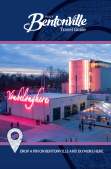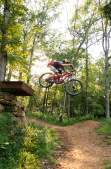It’s not often that you meet someone who wants to share their hidden stash of powder, whitewater, or singletrack. But for Brendan Quirk, cycling program director for Runway Group, a community-development organization in Bentonville, Arkansas, sharing is in his job description. “I would compare the density of trails here to what you might find in a place like Park City, Utah,” he says with the enthusiasm of a kid who can’t keep a secret. “They’re very flowy, with a nice mix of rolling hills and technical sections.”
Why does a small Ozark mountain town (population 49,298) need a cycling czar? And why have the Waltons, the town’s patrons and heirs to the massive Walmart fortune, donated nearly $20 million over the past three years to build 78 miles of off-road trails and 35 miles of greenway? As it turns out, Bentonville is just one of dozens of communities across the U.S. that have crunched the numbers and are actively trying to rebrand themselves as adventure hubs as a way to bolster or resurrect their economies. Nationally, outdoor recreation—including gear salesand tourism—accounts for $887 billion of the American economy and supports 7.6 million jobs, according to a 2017 Outdoor Industry Association report. At the local level, one University of Tennessee at Chattanooga economic study found that nearby crags, like Stone Fort and Tennessee Wall, drive a regional climbing-tourism industry worth more than $10 million annually, and whitewater parks, long a popular option for cost-effective economic development, generate millions of dollars per year in places like Reno, Nevada; Golden, Colorado; and Charlotte, North Carolina. Even existing tourism hot spots are looking to draw in younger crowds by expanding their adventure offerings. In 2014, Santa Fe identified not only mountain biking but also horseback riding as potential growth industries, due to the region’s year-round riding season and undeveloped open space.












